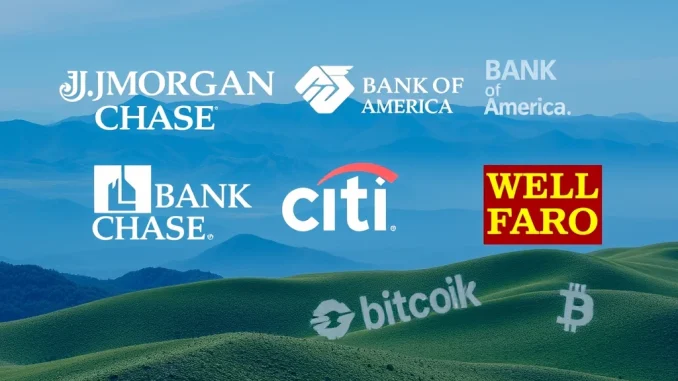
Big news is brewing in the traditional finance world that could have significant implications for the crypto market. According to reports, some of the largest US banks are exploring a collaborative effort to launch their own stablecoin. This move signals a direct response to the growing influence and innovation seen in the digital asset space, particularly from existing stablecoins and broader crypto competition.
Why Are US Banks Considering a Joint Stablecoin?
The primary driver behind this exploration appears to be the need for major financial institutions to adapt to the rapidly evolving landscape of payments and digital assets. As stablecoins gain traction for faster, cheaper transactions and potential use cases in decentralized finance (DeFi) and other blockchain applications, traditional banks face the risk of being left behind. A joint initiative could allow them to pool resources, standardize technology, and create a digital currency solution that leverages their existing infrastructure and regulatory relationships.
Key factors influencing this decision include:
- Countering Crypto Competition: Stablecoins like USDT and USDC have seen massive growth, facilitating billions in transactions daily. Banks want to offer a similar digital asset but within a regulated, bank-controlled framework.
- Improving Efficiency: A bank-issued stablecoin could potentially streamline interbank settlements, cross-border payments, and other financial processes, reducing costs and time delays inherent in legacy systems.
- Responding to Client Demand: Institutional clients are increasingly interested in digital assets. Offering a bank-backed stablecoin could meet this demand while providing perceived stability and security compared to non-bank alternatives.
- Proactive Regulatory Engagement: By developing their own solution, banks can work closely with regulators from the outset, potentially shaping the future regulatory environment for digital currencies.
Who is Involved? The Role of JPMorgan Chase and Others
According to the Wall Street Journal, the discussions involve major players in the U.S. banking sector. Names reportedly in talks include powerhouses like JPMorgan Chase, Bank of America, Citigroup, and Wells Fargo. This level of collaboration among typically competitive institutions underscores the seriousness of the effort and the perceived threat or opportunity presented by digital currencies.
JPMorgan Chase, for instance, already has experience with digital assets through its JPM Coin, a private blockchain-based system used for internal payments. Expanding this concept into a joint, potentially public-facing stablecoin with other banks would be a significant step, moving beyond proprietary systems to an industry-wide standard.
While details are still emerging, the involvement of multiple large banks suggests an aim to create a widely accepted and highly liquid digital currency that could function across the traditional financial system.
What Could a Bank Stablecoin Look Like?
It’s speculated that a joint bank stablecoin would likely be pegged 1:1 with the U.S. dollar, similar to existing stablecoins. However, key differences would likely include:
- Issuance and Reserves: Issued directly by regulated banks, the reserves backing the stablecoin would presumably be held in highly liquid, safe assets within the banking system, potentially offering a different risk profile than non-bank stablecoins.
- Regulatory Compliance: Designed from the ground up to comply with stringent banking regulations (KYC, AML, etc.), potentially making it more appealing for large institutions and corporate use cases.
- Integration with Existing Infrastructure: Built to integrate seamlessly with current banking systems and payment networks.
This approach differs from a potential U.S. Central Bank Digital Currency (CBDC), which would be issued directly by the Federal Reserve. A bank stablecoin would remain within the commercial banking structure, potentially positioning banks as key intermediaries in a future digital currency ecosystem.
Navigating the Challenges and Opportunities
Launching a joint stablecoin is no small feat. The banks involved will face numerous challenges:
- Collaboration: Getting multiple large, competitive banks to agree on technology, governance, and operational standards is complex.
- Regulatory Approval: Navigating the regulatory landscape for a new type of bank-issued digital asset will require significant effort and time.
- Technology: Building a robust, scalable, and secure blockchain or distributed ledger technology (DLT) platform that meets banking standards is critical.
- Market Adoption: Convincing businesses and potentially consumers to use the bank stablecoin over established alternatives or existing payment methods will be a challenge.
Despite these hurdles, the potential opportunities are substantial. A successful joint stablecoin could:
- Create a new, efficient payment rail for the digital age.
- Unlock new business models and services within the banking sector.
- Strengthen the position of traditional finance in the face of ongoing disruption from the crypto space.

The Future of Digital Currency: Banks vs. Crypto?
This exploration by US banks highlights the increasing convergence between traditional finance and digital assets. It’s not necessarily a simple ‘banks vs. crypto’ scenario, but rather an evolution where banks are seeking to adopt and integrate the underlying technology and efficiency benefits that digital currencies offer. Whether this joint stablecoin initiative comes to fruition and how it will compete with or coexist alongside existing stablecoins and potential CBDCs remains to be seen. However, the fact that major banks like JPMorgan Chase are actively working on this underscores the profound impact crypto competition is having on the financial industry and the growing inevitability of digital currency in the future of finance.
This development is a clear indicator that the line between traditional banking and the digital asset world is blurring, potentially paving the way for new forms of money and payment systems that bridge both worlds.



